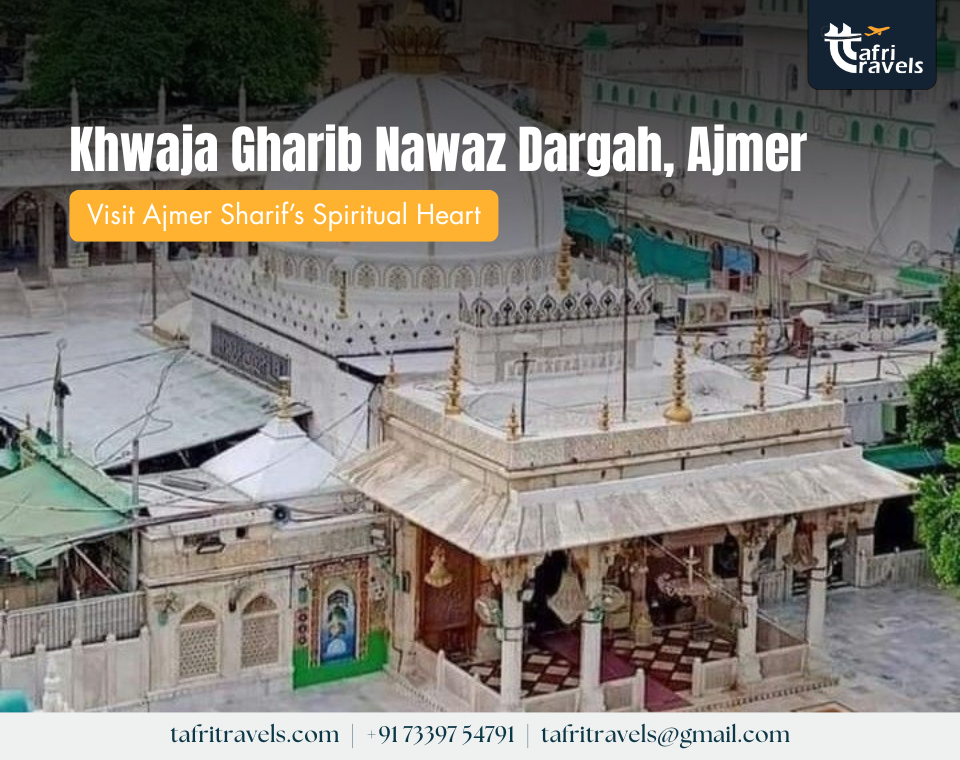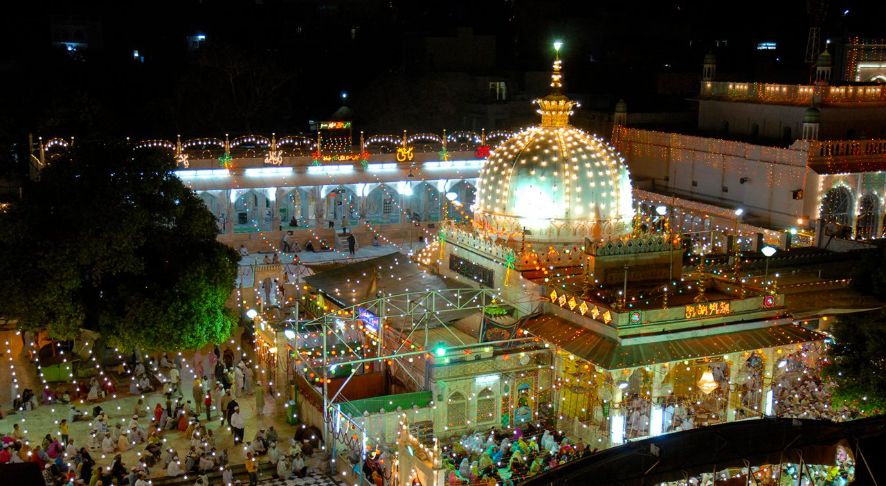
Khwaja Gharib Nawaz Dargah: Visit Ajmer Sharif’s Spiritual Heart
Table of Contents
ToggleOverview
Every year, millions of people visit Khwaja Gharib Nawaz Dargah Sharif in Ajmer, which is a famous Sufi shrine. Known for its sacred nature, it brings peace, blessings, and helps build a connection to God. Those of all beliefs come to find healing, offer their wishes, and join in on the daily ceremonies and Qawwali. Every mosque at the dargah contains courtyards and tombs, which provide a spiritual and enriching atmosphere.
History of Khwaja Gharib Nawaz Dargah Sharif
Hazrat Khwaja Moinuddin Chishti, the founder of the Chishti Order in India, is buried in the Khwaja Gharib Nawaz Dargah Sharif in Ajmer. Khwaja Moinuddin Chishti arrived in India from Persia in 1192 CE and proceeded to Ajmer to teach about love, peace and helping humanity. Due to his kindness and good works, people and leaders alike admired him and gave him the name Gharib Nawaz which means “Benefactor of the Poor.” With his death in 1236 CE, many people began visiting his tomb.
Akbar walked from Agra to visit the shrine and pray for his son, and Mughal emperors later enlarged the Dargah complex. Other Mughal rulers ensured the site grew and prospered. Now, this holy site represents unity, devotion and Sufi faith and lures people from all parts of the globe.
Explore the full list: Top Places to Visit in Ajmer in 2025
Architecture of Dargah

Its architecture mixes elements of the Mughal style with those found in Indo-Islamic architecture. White marble was used to construct the main tomb of Khwaja Gharib Nawaz which is crown with a gleaming gold-plated dome. In front of the tomb are many spacious courtyards, beautiful carved gates and two Mongul emperors’ mosques featuring detailed Islamic writing and marble artistries. The complex features interesting places like the Nizam Gate, Buland Darwaza, and the Mehfil Khana, where they organize Qawwali sessions. The impressive design enhances the religious and cultural value of the Dargah.
Spiritual Significance of Khwaja Gharib Nawaz Dargah

Why Devotees Visit the Dargah
Those who visit the Dargah believe in Khwaja Moinuddin Chishti’s miracles and seek his help for healing and suggestions. At the shrine, people come to pray, find peace and fulfill their hearts’ desires.
Religious Harmony and Belief System
Dargah is the place where Hindus, Muslims, Sikhs and many others can worship together in harmony. Through the faith, followers bond in admiration and regard for the saint’s thoughts on love, peace and caring for people.
Popular Rituals and Offerings
Some rituals at graves require placing chaddars on the tomb, lighting incense sticks and tying colorful threads wishing for good fortune. They engage in reciting the Quran and join in on Qawwali music designed to raise the religious feeling.
Journey through time: Adhai Din ka Jhopra – A Heritage Gem in Ajmer
Important points to remember
Visitors should be aware from some crucial visiting tips at Dargah:
- When visiting the temple, cover your body modestly and remember to remove your shoes.
- You are usually not allowed to use your camera inside the main sanctum; be aware of any rules set by your destination.
- Try to maintain silence and act respectfully during any religious ceremony.
- Go to the areas meant for your gender and adhere to the lines set up during praying.
- Ensure your belongings are safe and remember to be mindful of how people behave.
Best time to visit Khwaja Gharib Nawaz Dargah
You should visit the Khwaja Gharib Nawaz Dargah Sharif during the months from October to March, when the weather in Ajmer is pleasant. This is the best time to visit the shrine in peace. The Dargah sees a vast crowd during the Urs festival due to prayers, performances of Qawwali and various rituals. People who visit during this month get to experience both the exciting spirituality and unique cultural traditions.
Timings and Entry fees of Dargah
The Khwaja Gharib Nawaz Dargah Sharif is open both in summer, from 4:00 AM to 10:00 PM and in winter, from 5:00 AM to 9:00 PM. The place is open for everyone with no charges, so all visitors can seek blessings.
Explore more here: Shrine of Mu’in al-Din Chishti
How to Reach
The convenient ways to reach Khwaja Gharib Nawaz Dargah Sharif:
By air: Kishangarh Airport, located 25 km from the Dargah, connects Ajmer to major cities across India. Another option is Jaipur Airport which is 135 km from Ajmer. There are many flights heading there and buses and taxis are on hand to help you get to Ajmer easily.
By Train: Ajmer Junction offers easy and convenient trains with superior facilities from places such as Delhi and Mumbai. You can reach the Dargah which is only 1.5 km away, by using an auto-rickshaw or taxi.
By Bus: Many government and private buses connect Ajmer to Jaipur and Delhi. Buses to many destinations are easily accessible from the Central Bus Stand which lies near the Dargah.
Frequently Asked Questions
1. What is the Khwaja Gharib Nawaz Dargah famous for?
Ans: It is famous as the shrine of Sufi saint Hazrat Moinuddin Chishti, attracting millions for blessings and spiritual peace.
2. Which god is worshipped at Ajmer Dargah?
Ans: The Dargah is dedicated to Hazrat Moinuddin Chishti, a Sufi saint, not a god.
3. What is the story behind Ajmer Sharif Dargah?
Ans: It is the tomb of Hazrat Moinuddin Chishti, who spread love and peace after arriving in India in the 12th century.
4. Are ladies allowed in Ajmer Sharif?
Ans: Yes, women are allowed but must follow dress and prayer area rules.
5. What is special about Ajmer Dargah?
Ans: It is known for its spiritual atmosphere, religious harmony, and famous Qawwali sessions.
6. Who was Khwaja Gharib Nawaz?
Ans: Khwaja Gharib Nawaz, also known as Hazrat Moinuddin Chishti, was a revered Sufi saint who founded the Chishti Order in India. His shrine is in Ajmer.
7. What are the visiting hours of the Dargah?
Ans: The Dargah is open from early morning till late evening—typically 4:00 AM to 10:00 PM in summer and 5:00 AM to 9:00 PM in winter.
